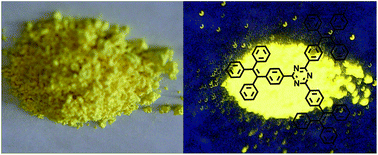Microporous, tetraarylethylene-based polymer networks generated in a reductive polyolefination process†
Abstract
Microporous Polymer Networks (MPNs) that contain aggregate-induced emission (AIE) active tetraphenylethylene (TPE) or other tetraarylethylene units have been generated in a reductive polyolefination process starting from four different tris(α,α-dichlorobenzyl)arene derivatives with dicobalt octacarbonyl or chromium(II)acetate as reductive olefination agents. Microporosity with moderately high BET surface areas up to 500 m2 g−1 could be combined with high solid state photoluminescence quantum yields up to 25.3% for polymer network P4. This unique combination should be promising for applications as optical solid state sensors, especially for MPNs with electron-deficient triazine core units.


 Please wait while we load your content...
Please wait while we load your content...